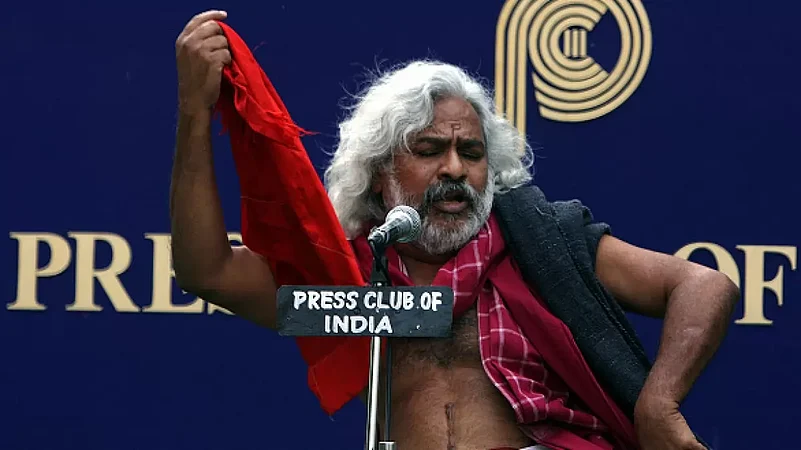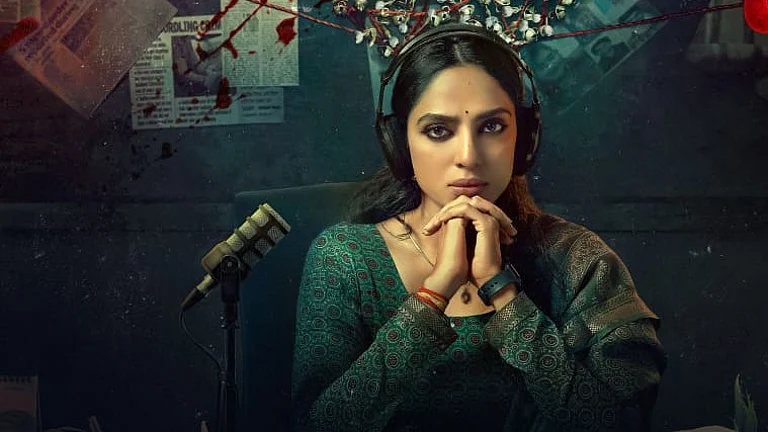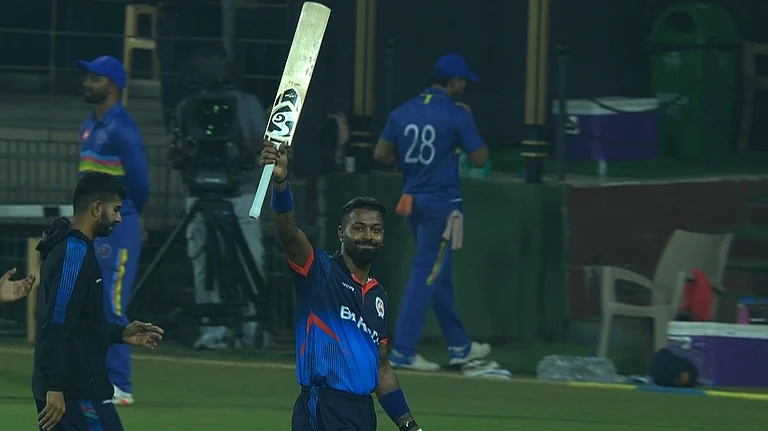Balladeer Gaddar carried a bullet in his body for 26 years — from April 1997, when suspected plainclothes cops sprayed five bullets on him, to August 2023, when he breathed his last at the age of 74. The bullet that remained in his body had missed his spine by a hair’s breadth. The assassination attempt, though, could neither bend his spine nor break his spirit. For, he was carrying in him fire that bullets were unable to douse.
Aag hain yeh aag hain
Yeh bhuke pet ki aag hain
Aasuyon ki angar hain
Yeh dukhiyo ka jhankar hain
Yeh aur bhatakti jaa rahi
Yeh dhadakti hui aag hain
(It’s fire! It’s fire!
Blazing from hungry stomachs
It’s the embers of tears
Rhythms of the oppressed
The fire keeps spreading
The flames are throbbing.)
For over five decades, Gaddar whirled on streets, on small and large dais, twirled the red rag that he usually wore across his chest, and spread the message of revolution, class struggle, and social justice with his folk-based political ballads in his powerful, rustic voice, punctuating his songs with fiery political speeches. He personified agitprop, the communist terminology for agitation and propaganda spread through art.
“The uniqueness of Gaddar is that he does not sing only with his throat. He moves his hands, his hands sing. He throws back his grey hair that is falling on his face, his hair sings. His legs adorned with gajjelu (ghunghroos, metallic bells worn on ankles) jump rhythmically. Movements of his body, his body language, the whole of his body is a song,” Telugu poet Kalekuri Prasad wrote.
Born as Gummadi Vittal Rao in a Dalit labourers’ family at Toopran village in Medak district of present-day Telangana in 1949, Gaddar enrolled in a pre-university course at Hyderabad’s Osmania University, which remained a hotbed of revolutionary politics and ideals for decades, in 1968. He joined the engineering graduation course the next year, only to drop out after the first year.
Gaddar was initially drawn to Ambedkarite politics and the Telangana statehood movement but, by 1970, was more influenced by the call of the Naxalbari to ‘overthrow the Indian state’ through an armed agrarian revolution to create a just social order. He got involved with a group called Art Lovers’ Association, which he helped transform into the Jana Natya Mandali (JNM) in 1972.
The formation of the Revolutionary Writers’ Association (VIRASAM or RWA) in 1970 and JNM in 1972 were crucial turning points in the Naxalite practice. In 1967-68, the Naxalites discarded all frontal organisations and took armed struggle as the only form of action. After the primary setback, the Andhra leadership started revisiting this idea in late 1969 and Virasam emerged as the first Naxalite ‘mass organisation’ or frontal organisation, followed by JNM. They marked the beginning of the overground activities of underground organisations.
Gaddar had briefly taken up a clerical job at a public sector bank during 1975-77 but quit it to dedicate himself totally to the work of JNM. He soon became a phenomenon.
He entertained, inspired, and, from the police’s point of view, incited thousands of people. He was a poet, a singer-songwriter, a revolutionary, whose songs, the police thought, beckoned communist guerrilla units. He was all of these — a revolutionary performer, an iconoclastic icon, who encouraged the oppressed to hit back.
In broad daylight
When they shoot your people
like birds in the sky.
Shoot back, explode,
Devour them.*
The more the JNM spread its wings, the greater became state repression. Several RWA or JNM members were killed and Gaddar himself lived an underground life for over four years in the second half of the 1980s, when he also spent a few months with a Naxal armed squad in the Dandakaranya forest region.
In the words of cultural theorist Brahma Prakash, who describes Gaddar’s genre as ‘choreopolitics’, Gaddar embodied “the mother of all caged birds” in contemporary India.
Art for propaganda
Music and rebellion or revolution have walked hand in hand in almost all societies and India has been no exception, with a rich heritage of protests music, from the anti-caste shahiri folk performance in late 19th century Maharashtra and patriotic songs of the early 20th century Swadeshi movement under colonial rule to the revolutionary mass songs of India’s early communist cultural stalwarts of the 1940 and 1950s.
Filmmaker Ritwik Ghatak, in his scathing criticism of the Communist Party of India (CPI)’s treatment of artists in the 1954 theses titled ‘On the Cultural Front’, accused the party of seeing its cultural front as a “money-earning machine” and a “mobiliser in meetings and conferences to keep the crowd (and not masses) engaged with whatever the artistes can offer”.
While his observations may have continued to hold true in many respects, artists, too, continued to spread the message of communism — Bhupen Hazarika and Hemanga Biswas through their songs in the 1950s and 1960s, Utpal Dutt and Badal Sircar with their plays in the 1970s and Safdar Hashmi in the 1980s, and the RWA and JNM of Andhra Pradesh onwards 1970s.
And if fund-raising, crowd-pulling, and keeping the gathering engaged have been criteria for communist artists, few have succeeded as much as Gaddar. Salil Chowdhury and Hazarika may have been bigger musical stalwarts known for their communist leanings but Gaddar is first a revolutionary and then a performer.
And yet, it was the power of his performance that helped him serve his purpose — spreading the message of revolution. There is no other example of an artist enjoying such popularity and acceptance as he despite preaching ‘revolutionary counter-violence’ for four decades.
As human rights activist K Balagopal pointed out in a March 1990 article: “The public meeting organised on February 20, 1990, by Jana Natya Mandali, the people’s cultural organisation whose architect Gaddar is by now known all over the country, was attended by a lakh and half people… a number well in excess of the brightest show NTR (N T Rama Rao) and his friendly opposition parties had ever put up.”
By ‘brightest show’, Balagopal referred to the public meeting held in late 1984 to protest the dismissal of the NTR government, addressed by prominent leaders of anti-Congress parties, including Farooq Abdullah, Jyoti Basu, and Atal Bihari Vajpayee.
Gaddar pulled such massive crowds despite the fact the force he was known to represent —the CPI(ML)(People’s War)— was waging an armed struggle against the Indian state itself, with its supporters/sympathisers facing immense State repression. He sang to a sea of people, glorifying the martyrs, the innumerable youths who left their homes to deal a body blow to landlordism.
Our eyelids fly open with the slightest noise at the door
Maybe the one who is gone has returned and called
I have your meal ready, and hidden,
your father and brother don’t know,
The back door is shut, but not bolted
Will you come with the stealthy steps of a cat, children?**
The 1940s and 1950s mostly saw communist cultural personalities performing in the urban centres but the call of the Naxalbari movement was to ‘go to the villages’ and it brought many cultural activists face to face with guns — some joined guerilla units and some created art to garner public support for the revolutionaries. Many of them got jailed, brutalised and killed.
In Bengal, this includes CPI(ML) politburo member Saroj Dutta, who has remained untraceable since being picked up by the police in 1971, and grassroots-level organisers Dronacharya Ghosh, Timir Baran Singha and Murari Mukhopadhyay, who were killed in jail. They were all poets. Theatre artist Prabir Dutta died in police caning during a street performance in Kolkata in 1973.
Bengal and Andhra were the two states to first witness communist-backed armed agrarian revolutionary activities, during the Tebhaga and Telangana movements, respectively, in the late 1940s and the early 1950s. It is in these states where the CPI’s cultural front, the Indian People’s Theatre Association (IPTA), was the most active. And these were the states first rocked by the revival of the same call in 1967 — first in Naxalbari of Bengal and then in Srikakulam of Andhra.
The Telugu artists espousing Maoism had no different fate than their Bengali counterparts — the balladeer Subbarao Panighragi, who became one of the leaders of the Srikakulam movement, was killed in 1969 and the likes of poets Cherabanda Raju and Varavara Rao became regulars in jails since the beginning of the 1970s.
It is in these turbulent times that alias Gaddar emerged in the flaming fields of Andhra Pradesh, particularly areas making up the present-day Telangana state. He not only drew inspiration from Marxist proletarian internationalism and the Maoist doctrine of protracted people’s war but also from spiritualist social reformers of previous centuries like Kabir and Tukaram, colonial-era patriots like Bhagat Singh and anti-caste activists like Jyotiba-Savitribai Phule and B R Ambedkar. It is for a reason that Vamshi Vemireddy and Sasi Kiran R. Mallam described him as a ‘Transhistorical Figure’.
For his musical form, he inherited the communist legacy on the one hand —including the works of IPTA Andhra chapter’s leading artists like Nazar and Suddala Hanumanthu during the late 1940s— and the folk music and theatre forms on the other.
According to Delhi University Professor P Kesava Kumar, Gaddar was one who explained “political economy of Marx or Mao’s philosophy in simple songs or words without borrowing any textual language of Marxism”.
And unlike most of his predecessors in the Leftist cultural movement, he set his focus more on rural areas than urban ones.
“Gaddar and JNM made a radical intervention in the progressive theatre movements of India, as well as in the larger field of political theatre and ‘folk performance’,” Prakash wrote in his 2019 book, Cultural Labour: Conceptualising the ‘Folk Performance’ in India.
He identified the JNM as “perhaps the first leftist political theatre troupe in India that broke the hierarchy of the middle class in political theatre” and said that Gaddar and the JNM had “bridged the gap between the people’s progressive culture and popular culture”.
Camaraderie and conflict
Nevertheless, just like there is hardly a Marxist artist worth a mention who did not have a problem with the communist party she or he was associated with, Gaddar fell out with the CPI(ML)(PW) over a range of issues. He got suspended from party membership in 1995, an event that he later said dealt him a severe mental blow.
Usually in such conflicts, either the party accuses the artist of behaving in an ‘individualistic way’, or the artist blames the party for curbing artistic freedom, or both ways. In Gaddar’s case, the party labelled similar charges. Gaddar defended himself publicly without criticising the party.
One of the points of conflict was his stress on the caste question. He had been addressing the question of caste-based violence quite regularly since 1985, when he also inaugurated the massive Dalit protest gathering at Chirala town in Prakasam district against the murder of six Dalits by the upper caste people. Nevertheless, as political scientist Ajay Gudavarthy pointed out, the Dalits did not accept his party’s stance of describing the attack as one ‘by landlords on labourers’ instead of calling it an attack by “Kamma (upper caste) landlords on Madiga (Dalit) coolies”.
Gaddar did not open up about this conflict in public but writer-activist Vidya Bhushan Rawat noted that Gaddar had started putting up posters of Ambedkar and Buddha at his residence by the early 1990s. Kalekuri Prasad considered Gaddar to be closer to the likes of Buddha, Kabir, Phule, and Ambedkar than Marxist icons. “Gaddar loved Marx just like Ambedkar loved him. However, he drew inspiration from the Indian Social revolutionaries. And there is no second thought that Gaddar is a Marxist,” Prasad wrote.
Gaddar opened up about this conflict with the party much later. “I had a debate with my parent party in which I opined that in addition to Marxist knowledge, we have to incorporate the ideologies of Ambedkar and Phule to the Indian context to liberate our society made up of caste and class,” he said in April 2017 while formally announcing his parting of the way with ‘mother-like party’.
The 1995 suspension was withdrawn, probably the next year, and they came closer. He became the general secretary of another cultural wing of the party, the All India League of Revolutionary Culture, in 2000. In 2002, the party named him, Varavara Rao, and G Kalyan Rao as its emissaries in the peace talks with the government.
Gaddar finally quit the party —named CPI(Maoist) in 2004— in 2012 and forayed into mainstream politics. He, though, could not make any distinct mark. Perhaps, his image as the revolutionary performer had got too deeply etched in the memory of his own people to accept him in any other role. The sea of people that gathered to pay him their last respects stands as proof — people may not have stood by him in his latest political ventures but he continued to be loved, dearly loved.
(*Vasanth Kannabiran’s translation of Gaddar’s song, A Slave Life.
**Paras Venkateshwar Rao Jr and Antara Dev Sen’s translation from the Telugu song ‘Vandanaalu biddalu’)


























